What you need on your CBD labels and packaging
More articles you might like:
In recent years, the popularity of cannabidiol (CBD) products has skyrocketed, with consumers increasingly turning to these remedies for various purposes, from managing pain to reducing anxiety. However, with the rapid growth of the CBD industry comes the need for clear regulations and guidelines to ensure product safety and consumer confidence. One critical aspect of this is the labeling and packaging of CBD products.
CBD labels serve as a vital communication tool between producers and consumers, providing essential information about the product’s contents, usage, and safety precautions. As such, adhering to CBD label requirements and guidelines is paramount for businesses operating in this sector. Here’s what you need to know:
The Food and Drug Administration (FDA) reported to Congress on rampant mislabeling in the CBD industry in 2020. According to the law firm Akin Gump, the FDA sent a report to Congress on the excessive mislabeling of CBD products. The report outlined the testing of 200 hemp products being sold online.
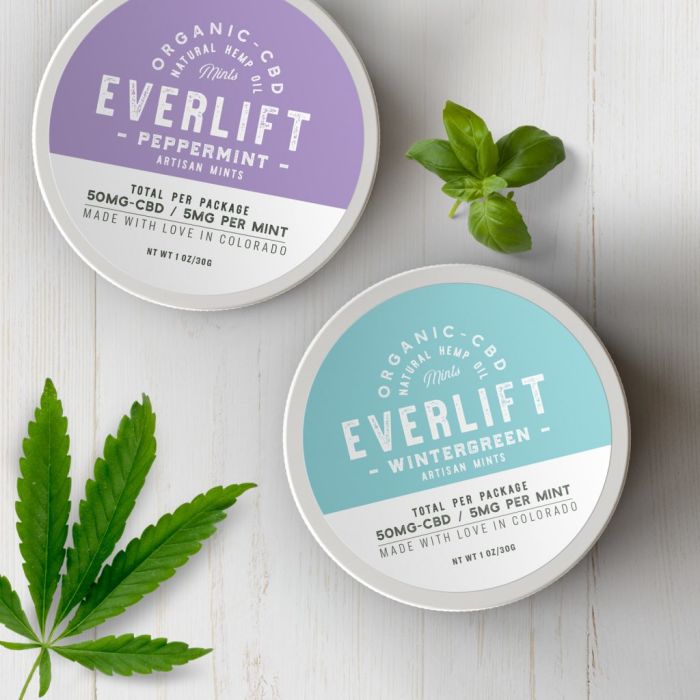
Akin Gump stated that “Of the products tested thus far that indicated a specific amount of CBD, almost 55 percent contained a CBD level that differed from the labeling by more than 20 percent. Just under half of the products tested contained THC or a related compound. Hemp products must contain no more than 0.3 percent THC to avoid potentially facing scrutiny for containing marijuana, which remains an illegal substance under federal law.”
The testing was put on hold due to the pandemic; however, the FDA plans a more comprehensive study in the near future.
FDA sends out warnings
One example of the warnings the FDA is sending to CBD manufacturers is a letter sent to The Dragon Tree Apothecary. The warning letter stated the CBD company was in violation for using false claims on their product labels and website.
“Based on the inspection and a review of your product labels and your websites, we have identified serious violations of the Federal Food, Drug, and Cosmetic Act (the Act) and applicable regulations,” the FDA said in the letter.
It goes on to say, “…the claims on your company’s product labels and websites establish that your products are drugs under section 201(g)(1) of the Act [21 U.S.C. § 321(g)(1)] because they are intended for use in the diagnosis, cure, mitigation, treatment, or prevention of disease and/or intended to affect the structure or function of the body.”
The letter contains a laundry list of violations the company committed in its product labeling and website claims by calling their products dietary supplements or stating they are intended for use as a drug, such as “relief of cold and flu symptoms” and “anxiety relief.” The company appears to no longer be selling CBD products.
What you need to know
Since the FDA doesn’t currently allow the sale of CBD ingestible products, it’s important to note the labeling requirements on a state-by-state basis. Some states permit the sale of CBD in foods and dietary supplements but require specific label information and warning requirements. To help you understand where your product fits, the FDA has put together a list of the 26 most common questions about cannabis products and their regulations.
We’ve put together some important things every CBD seller should include on their CBD product labels. We’ve also included some common mistakes you should avoid.
At a minimum, you should follow the FDA regulations for cosmetic product labeling for your CBD-infused products below. If you’re selling in a state that allows edible CBD products, then make sure to check state regulations for CBD label requirements.
- Do not make any false or misleading claims about treating or preventing disease. The FDA has already sent warning letters to companies selling CBD products that have made these false claims.
- Properly display your label information (See 6 items below) and make sure it’s legible.
- Do not violate the Poison Prevention Packaging Act of 1970.
CBD Labeling Guidelines
Basic requirements you should include on your CBD product labels:
1. Product identity
This is what your CBD product is or does. You must include it on the Product Display Panel (PDP) of your container. This is not the brand or trade name but it must be easy to locate and see. It doesn’t have to be on the inner container of a product, but putting it in both places is often helpful to consumers.
2. Net quantity of contents
You must state the amount of the actual product without any packaging or container, as well as the amount of active CBD per serving. This must be a measure of volume for liquids or weight for solids. The net contents must appear within the bottom 30% of the PDP of the outer container and on an informational panel on an inner container.
3. Name and place of business
The label should prominently display the name and contact information of the manufacturer or distributor. This allows consumers to reach out with any questions or concerns and adds transparency to the product’s origin.
4. Ingredient declaration
A comprehensive list of ingredients used in the CBD product should be provided on the label. This includes not only CBD and THC but also any other active ingredients or additives present in the formulation. This information helps consumers make informed decisions, especially if they have allergies or dietary restrictions.
5. Warning or caution statements
It’s a good idea to include the standard warnings for children and pregnant women on your labels. As well as warnings for any complications people taking other medications might have. It’s also a good idea to include a warning that users could fail a drug test if consuming hemp products.
6. Disclosure of material facts
These are any facts that a reasonable person would deem to be important, significant, or essential when buying your product. For instance, if your CBD oil is only good for nighttime use, then you should disclose that.
Other things that you should consider including for consumers:
- Whether your product is full-spectrum, broad-spectrum, or isolate
- Expiration date
- Manufacturing date
- Batch codes
Please note: The suggestions above are just guidelines. You should consult all federal, state, and local regulations that pertain to your CBD product before completing your labels.
What CBD labels are right for you?
Avery offers a huge catalog of CBD labels that are easy to order online. You can simply personalize and order professionally printed CBD labels by the roll or by the sheet. Or you can order blank CBD labels by the sheet that you can print from a laser or inkjet printer.
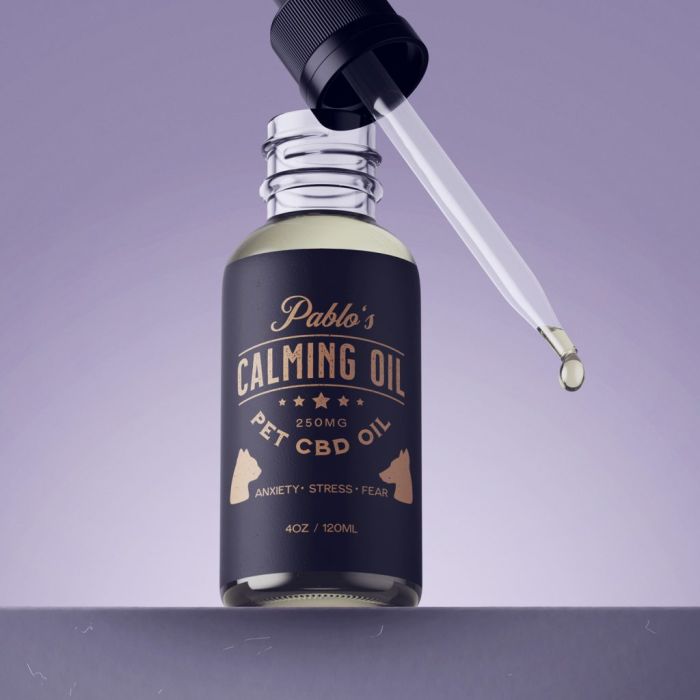
Find the right material for your CBD including waterproof and CBD oil-resistant films, metallics, glossy, clear, and many more. Also, Avery offers thermal transfer roll labels that are available in white, chrome, and metallic film.
You can easily create and order your CBD labels to your exact specifications, all online. You can also generate barcodes and QR codes or custom compliance labels for your specific state. Just customize with your compliance needs and order.
Conclusion
As the CBD industry continues to expand, ensuring compliance with label requirements and guidelines is essential for both businesses and consumers. Clear and informative labeling not only fosters trust and transparency but also promotes safety and responsible usage. By following these guidelines, CBD producers can navigate regulatory landscapes more effectively while providing consumers with the information they need to make informed choices about their CBD products.
If you need help choosing the right labels, please call our California-based Customer Care Center at (800) 942-8379.

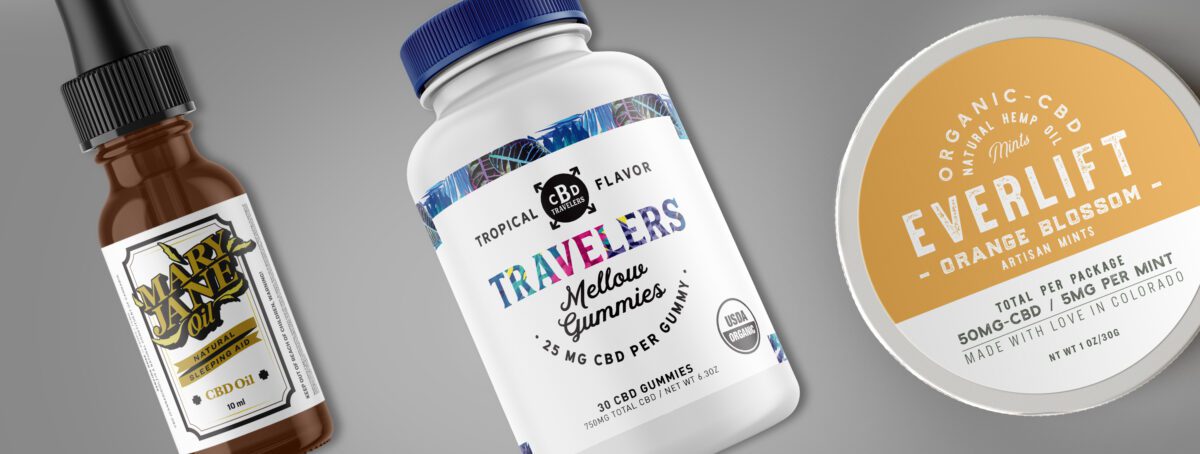
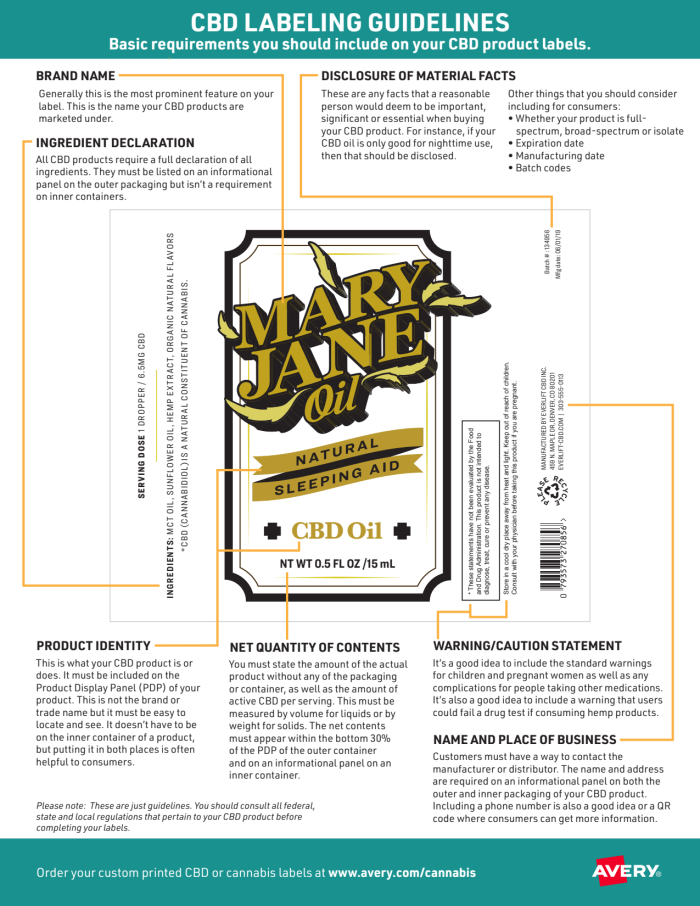
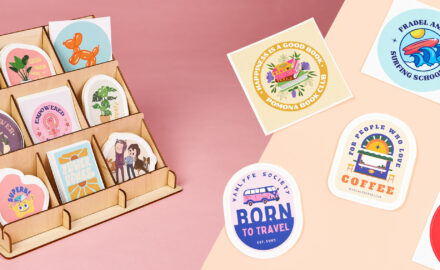


I am trying to start up an edibles tincture and rub product line, and Need to know what is supposed to be on the labels. I understand the following;
product name
brand name
quantity inside
mg per unit
sku
batch number. Can you please advise if I need more
Phylis,
These are the basic requirements that you must have on your CBD labels. But you should check with your local and state regulators as well since many states have completely different labeling laws. We advise checking with an attorney to make sure you have everything you need on your label before ordering them. Let us know if we can help with creating and ordering your CBD labels.
How would I label a muscle rub with cbd and essential oils in it? Does calling it a muscle rub, make it a drug and not a cosmetic?
Ashlee,
It depends on how you describe your muscle rub. If you say that a product ingredient can heal or cure, it becomes an unapproved drug.Check out this example for a company that did it wrong. Avery recommends you contact an attorney or the FDA before you print or order your labels to make sure you’re doing it correctly. I hope this helps.
We are thinking of offering a honey product with 100mg of hemp (isolate) with NO THC per serving.
Can our ingredient panel simply state “US Grade A Honey, Hemp Isolate”? These are the only 2 ingredients for our honey product.
Glenn,
You should be fine with that as long as you list everything in your CBD product, but I am not a lawyer, and I’m strictly going off the FDA guidelines. And with all the confusion going on with CBD and cannabis labels right now, I would suggest that you contact the FDA to make sure you are doing everything correctly. Questions concerning the labeling of food products may be directed to the Food Labeling and Standards Staff (HFS-820), Office of Nutrition, Labeling, and Dietary Supplements, Center for Food Safety and Applied Nutrition, Food and Drug Administration, 5001 Campus Drive, College Park, MD 20740-3835, Telephone: (240) 402-2371. Hope this helps.
What if some one is selling products without any labels just a their company name? How can you report that
Layla,
Thank you for the question. You can report products that are mislabeled to the FDA. You can call the FDA Consumer Complaint line for your state listed here. Or you can report it online at the FDA Safety Reporting Portal. I hope this helps. Let us know what you find out. Thanks for reading.
Interesting post. Would like more information on ointments containg full spectrum hemp oil
its fascinating post and You included all the necessary information for us to make a better decision and presented the information in a one-page table that was really easy to read. Your work made it really easy to make a perfect decision. Great job!
I’d like to get more info about design and printing labels for 1oz tincture bottles.
Thanks
Clayton,
Thanks for that suggestion. We will add that to our upcoming content ideas. If you need some help right now, please feel free to call our customer care center. We’re open and doing business and they’d be happy to help you design and print your bottle labels. Call them at (800) 942-8379.
How does nearly every CBD product have a Dietary Supplement Fact label on it if the FDA says it isn’t a dietary supplement?
It’s because of all the confusion over regulations we believe. There are a lot of mislabeled products on the market. And each state also has different laws. It’s always our recommendation to check with your local, state and FDA regulations before labeling any product.
Avery – I’d like to use your labeling graphic for an upcoming legal education course on CBD labeling and marketing. Would Avery grant a license to use the graphic for that narrow purpose?
Olivia,
Thank you so much for reaching out. Due to the confusing and constantly changing CBD label regulations, Avery would prefer if you just share the link to the post or the post itself and not only the graphic. It’s a topic we’re keeping close eyes on, and if the guidelines change we will update the article and graphics as well.
Again, thank you for reaching out. Good luck with your course!
What are the label requirements for hemp flower verses a tincture?
Since tinctures are ingestible you’ll need to follow the FDA guidelines for dietary supplements. The more information you put on your labels, the better off you and your customers are.
#4 states that “Disclosure of material facts: They must be listed on an informational panel on the outer packaging but isn’t a requirement on inner containers.”
Can you clarify what that means exactly?
Let’s take for example the common CBD oil/tincture…
Does this mean you NEED to place your CBD vial inside some sort of box or envelope? Whereas the box/envelope would contain this required information?
OR…
Does this mean you CAN put this required information on the vial itself? (that is if it fits and is legible; e.g. 6pt font size)
Thank you for your question. To clarify, if your product has outer packaging, it must be on the outer packaging. So if you don’t have outer packaging it can be on the vial itself. Consumers need to be able to read the ingredients without opening the packaging.
I’ve clarified it in the article. Hope this helps.